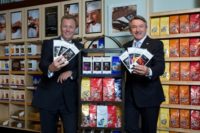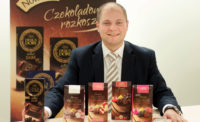On July 14, 2014, when the Lindt & Sprüngli Group announced that it was acquiring Russell Stover Candies, the news raised some eyebrows within the U.S. chocolate market. While few were surprised to hear that the Kansas City chocolate manufacturer was acquired — the industry knew Russell Stover was on the block — the final deal generated closer scrutiny from not only industry participants, but observers as well.
But for Lindt & Sprüngli, the acquisition marked the company’s “Biggest and most important strategic acquisition to date,” emphasized Ernst Tanner, chairman of the Lindt & Sprüngli Board of Directors and Group CEO. It was, as he added, “A unique opportunity for us to expand our North American chocolate business and will greatly enhance the group’s status as the leader in premium chocolate in the world’s biggest marketplace.”
More than a year and a half after the purchase — the deal was finalized on Sept. 8, 2014 — the integration of Russell Stover Candies into Lindt North America is in full swing. Andreas Pfluger, president and ceo of Russell Stover Candies as well as head of Lindt North America, affirms that the Lindt Credo, which hangs in his office next to the doorway, is being implemented across all segments of the company.
Looking back at 2015, Pfluger says the company “met its objectives” regarding integration. As he pointed out, there were several regulatory, structural and financial hurdles to resolve first before deep drilling into the integration process could begin.
“Russell Stover was a privately owned company,” he explains. “As a publicly traded company, there are certain financial rules, reportings and corporate governance we had to meet. We also had to integrate our organizational ‘point of view’ to make it similar with the rest of the Lindt Group.”
In doing so, Pfluger quickly strengthened the sales and marketing departments, “Lindt is a marketing and sales driven organization,” he said, so adding talent for both groups was critical.
“We implemented changes in the organizational structure,” he continues. “In manufacturing, we started taking advantage of Lindt’s know-how and introducing that into operations. We’re also looking at how we manage the supply chain and our manufacturing processes. But everything we’ve done and are doing with regards to change is done to give us leverage in the long run.”
As Pfluger points out, “We acquired Russell Stover to build the business in the long run. When we acquired Ghirardelli 15 years ago, which we successfully integrated, it was with the same mindset.”
Moreover, during the due diligence process, it became very clear to Lindt’s executives what they were getting.
“The Ward family was very open, fair and transparent in the process,” Pfluger says. “We were aware of what the company was all about; there were no skeletons in the closet. We knew we were getting a well-managed group.”
Lindt & Sprüngli was also getting a strong company culture, a culture that proved to be a pleasant surprise for Pfluger.
“There’s definitely a strong culture in Russell Stover; you feel the pride of people who know they are working for a great chocolate company,” Pfluger says. “They are proud and excited to work for this company.”
Of course the next question was whether they would be proud to work for a new owner?
All signs suggest yes. After all, Lindt & Sprüngli’s track record is impressive: It’s credited with establishing the premium chocolate market in the United States. With the acquisition of Russell Stover, Lindt North America is the third largest chocolate manufacturer on the continent, trailing only Hershey and Mars.
And its track record with Ghirardelli simply reaffirms the company’s winning philosophy of integrating best practices from both parties.
“I definitely see a willingness to change, to take advantage of opportunities in a positive way,” Pfluger says. “I see people growing, from young people to not-so-young. And that only means we’re building a stronger culture than before.
“There’s also an openness, a ‘Let’s give it a go’ approach,” he adds. “I see them embracing the Lindt Group. One of the reasons they do stems from the way we integrate organizations. We always respect the culture. And it’s different than the culture at Lindt USA or Ghirardelli. But we want to keep it like that; it a culture that’s driven by pride.”
He cites the company’s beginnings, which date back to 1923 when Russell Stover began making chocolates in a Denver bungalow. Then there’s the Whitman’s brand that traces its origins back to 1842, making it the oldest chocolate brand in the United States.
“We also have Pangburn’s, which goes back to 1914 and remains part of the fabric of Texas,” Pfluger says. “We’re talking about some of the most respected and traditional brands in the United States. The former management was able to build leadership positions within the boxed chocolate category, also seasonal leadership during Valentine’s Day, Easter and Christmas, as well as the sugar-free chocolate segment. We’re definitely the leader in gift-giving, which really personifies Russell Stover.”
Pfluger was also very appreciative of Russell Stover’s Midwestern roots, which lend themselves to a “very grounded, substance over style, content before noise” culture. The chief executive says that’s evident with the “get things done” attitude and a strong level of professionalism prevalent at Russell Stover.
“Our goal is to make that even stronger,” he says.
To do so, the company is implementing the Lindt Group’s quality requirements across all operations.
“We want to be even more consistent in quality than ever before,” Pfluger explains.
As Greg Carlson, v.p. of operations, says, “Russell Stover has always been about quality. However, we want to take advantage of the quality processes existing at Lindt to enhance what we have. When you are running your own business, you do what you know. Now, with the Lindt Group, we can take the best practices and incorporate them in our operations.”
Oftentimes, that not only means adding procedures and/or processes, but streamlining and/or eliminating them. And SKU management can help sharpen that focus as well as improve efficiencies.
During the past year the company reduced its large catalogue of products to remove any non-strategic items. That continues to be an ongoing process, one that’s carefully dovetailed with consumer research — research that’s designed to be a road map for the company’s strategic growth plan.
“We believe that there’s a huge opportunity in the gift-giving segments for us,” Pfluger asserts. “We see plenty of white space for an alternative in the market, one that provides new excitement. We’re more experienced than other players in the category as well as very appreciated and trusted by consumers. They [consumers] trust the brand.
“We haven’t been exploiting the gift-giving opportunities,” he continues. “For example, there are birthdays to be celebrated. In addition, one can simply gift chocolates as a casual way to say thank you.”
Pfluger cited the company’s famous Whitman’s Sampler gift box as a delightful way of providing variety and excitement for the consumer.
“There are 14 recipes in a Sampler box,” he says. “How about making that variety more interesting by taking it out of the box? Chocolate is all about indulgence. How about giving myself a treat, say once a day or twice a week?”
“Gift-giving isn’t limited to the seasons,” Pfluger adds. “Look at the boutique chocolatiers that sell small, five-piece boxes as samplers. Consumers are anxious to discover new flavors; they want their products to be playful. They are looking for excitement, indulgence, purity. It’s all about surprising them.”
And that’s where the collective strength of Lindt North America can make an impact. As Pfluger points out, there are three research and development centers — Lindt USA, Ghirardelli and Russell Stover — working with an urgency for the North American market.
“After all, consumers are looking for innovation. Today, it’s mandatory to be the innovation leader. And innovations are driven by marketing, by ongoing trends and by consumer research. Innovation has always been one of our pillars; we are now going to add some excitement to that pillar.”
Pfluger didn’t waste any time in seeking out the right individual to bring that excitement to Kansas City. As Marjolaine de Clavière, v.p. of marketing for Russell Stover Candies explains, Pfluger recruited her internally by posing a simple question, “Do you want the most exciting marketing job in the [Lindt] Group?”
de Clavière didn’t hesitate. Her experience at Lindt not only encompassed overseeing the Lindt Excellence brand as brand manager as well as launching several innovation blockbusters like Excellence with a Touch of Sea Salt or Excellence 90%; it also included eventual responsibility for bars worldwide. Those were the credentials Pfluger was looking for. And since coming on board in January 2015, it’s been a whirlwind for her.
“I’ve met so many amazing people here at Russell Stover,” she says. “I know that’s typically a cliché that everyone uses, but for me it’s true. I really didn’t know how I would be welcomed here, and I was a bit anxious. But everyone here has welcomed me with open arms.”
Moreover, it didn’t take long for de Clavière to make an impact; one of the first things that came about, in addition to learning about the company’s portfolio and visiting customers, was expansion of the marketing team. It tripled in size.
“It was a small team, but we really have a large portfolio,” she says. And de Clavière quickly embraced Russell Stover’s 12-person in-house creative team, which adds flexibility and speed to new product introductions.
And there are and will be many, de Clavière asserts. Nonetheless, all are grounded in consumer research, which is critical to the way the company goes to market. Earlier this spring, the company began rolling out its new Everyday line of chocolate items.
The number one focus within the Everyday Range is the “Favorites” sub-range of stand-up bags. As the name implies, “Favorites” takes some of the company’s most popular boxed chocolate pieces “out of the box,” such as Pecan Delights, wraps them up individually and literally places them in a stand-up bag. In addition to the Pecan Delight Favorites Bag, consumers will also find one for Caramel, Coconut, Mint Patty and an Assorted selection of all four.
But it’s not just about ”Favorite” chocolate pieces from Russell Stover’s boxed chocolate selection; it’s also about new items, such as Pomegranate, Blueberry and Orange flavored Bites; Coconut, Pecan Delight and Dairy Cream Caramel Minis; as well as Pistachio and Crunchy Caramel Barks. Sweet and savory fans will also find Double Dipped Pretzels with Sea Salt in the rollout. Whereas Favorites will be individually wrapped in stand-up bags, the rest of the range will present itself in re-sealable pouches, perfect for snacking occasions.
There are also new additions for sugar-free shoppers, such as the fruit trio of Blueberry, Orange and Cranberry flavored Bites.
Long a leader in seasonal, the new launch signals Russell Stover’s intent to expand its Everyday offerings. As Pfluger points out, the company’s current mix of sales runs heavy toward seasonal — two-thirds seasonal versus one-third for every day.
He believes that’s a clear opportunity for the company.
“We’d like to reverse that ratio, thereby reflecting the market,” Pfluger says. “In doing so, we’d be twice the size.”
As he points out, “There’s no need for consumers to wait for the next season before they can get another Russell Stover product,” he says. “And consumers trust us.”
So do retailers, says de Clavière.
“Buyers like Russell Stover,” she says. “But they have been waiting for something to happen from one of the most important players in the U.S. market. And we have big ambitions, big plans. It’s up to us to execute them.”
Earlier this year, the company teamed up with Hudson News, which has hundreds of retail outlets in various transportation hubs such as major airport and train stations across the United States, to launch a “Favorites” promotion centered on pairing up best-sellers and the new product line.
The Everyday range ramp up will continue throughout the summer as the company kicks off a major, yet focused, public relations campaign to drive awareness and sales.
“In addition to nationwide in-store sampling of products amongst key retailers, we’ll be using digital tools to get the word out amongst key influencers,” she says.
“It’s all about on-the-go indulgence,” de Clavière continues. “It became clear to us that everyday products were missing in our portfolio. But that’s a mega trend. Consumers are looking for good quality chocolate. They want to satisfy a craving; they want to share a piece of joy. And our new products address those needs by targeting the everyday consumer.”
And how were the Everyday “Favorites” chosen to be Favorites?
“Of course, we asked for recommendations,” she responds. Those recommendations encompassed consumers, employees and buyers. Critical feedback also came directly from Russell Stover’s 35 retail shops, which are on the front line of direct consumer contact.
As mentioned earlier, the Everyday launch represents just the tip of the Russell Stover innovation iceberg. There’s much more coming for the sugar-free category.
“There’s been a lack of innovation and ideas in the sugar-free segment,” says Pfluger. “We’ll change that. There are many innovations coming, but we want to make sure we get them right before we launch them.”
Getting it right involves “designing products that meet the needs of the consumer,” adds de Claviére. “We want to give them products that taste good and satisfy their cravings. Consumers don’t want to compromise on taste.”
It would be incorrect, however, to assume that the new Lindt team is ignoring Russell Stover’s seasonal business. Here, too, the push is to grow share, says de Clavière.
“We are focused on listening to the consumer, doing research,” she says. “For example, we’re leaders in the flatback chocolate rabbit segment for Easter. We are working on introducing several innovations for Easter 2017. It’s all about making that Easter egg hunt more exciting.”
With more than 2,000 SKUs on hand, there’s ample existing items to choose from that can provide that excitement.
For example, barks have been a staple at the company’s retail stores for years, says Carlson. Their introduction into the Everyday line simply involved tweaking production to accommodate the new packaging.
But then flexibility and nimbleness have always been key trademarks of Russell Stover’s manufacturing prowess.
“We continue to produce confections from our kitchens using small batches,” he says. When one considers the range of chocolates that can go into a typical box of Russell Stover chocolates — anywhere between 21 to 30 products with 20 to 50 different centers — it’s evident why a small batch process makes sense.”
And Pfluger sees that as a strength few companies have.
“We employ many specialists, candy makers that have the know-how to create fillings like caramel, mint or coconut ,” he says.
Carlson, who was part of the four-person team that was involved in the sale of Russell Stover, says the acquisition of the company by the Lindt Group proved to be the best-case scenario for the company.
“They know the legacy of the brands, what we do as a company, our core beliefs, and they are intent in keeping that intact during the integration process.”
Lindt is also intent on introducing its strengths into Russell Stover.
“They definitely have a great deal of experience on the back half of operations that we can take advantage of, particularly when it comes to pack type and wrapping equipment,” he says. “We’re looking to leverage what Lindt has regarding their experiences and bring that in-house.”
And the input has been welcomed. As Carlson notes, his team’s “dedication and expertise has been one of the keys to facilitating a seamless transition.”
Given that Russell Stover’s four manufacturing facilities (Iola and Abilene, Kansas., Corsicana, Texas and Montrose, Colorado.) represent 1.5 million sq. ft. of “manufacturing goodness,” as Carlson calls it, there seems to be plenty of production power on hand.
Carlson also points out that the company has its own transportation fleet as well as its own rigid box-making capabilities.
“Having an in-house transportation fleet gives us a cost advantage along with flexibility and quick turnaround for the new innovations that are demanded in today’s marketplace,” he says.
“It’s a big advantage, particularly for a confectionery company that is still very seasonal,” Carlson adds. “Otherwise you are at the mercy of the trucking companies. This way we control our own destiny.”
Then there’s the advantage of having one’s own rigid box-making capabilities.
“Our Butler Box facility in Butler, Mo. can die cut, emboss and print,” he explains. “The components are sent to the factory where we can assemble the boxes on demand.”
Once again, it provides the company with added flexibility.
“There’s tremendous positivity and enthusiasm for the future,” says Carlson. “We’re now part of a much bigger, worldwide organization that has a strong focus on marketing, sales and quality. We’re looking to take those strengths and apply it to the business.”
Given the “getting things done” culture at Russell Stover, it’s what the Lindt Group is betting on.
As Carlson asserts, “I see a very good future for the company.”
At-a-Glance: Russell Stover Candies
Headquarters: Kansas City, Mo.
Sales: $700 million; Lindt North America - $1.626 billion (Lindt USA, Ghirardelli and Russell Stover Candies)
Employees: 3,084
Output: 90 million lbs.
Products: Moulded pralines, moulded chocolate novelty items, panned chocolate products, barks, clusters, enrobed pralines.
Plants: 4 candy factories (Abilene and Iola, Kan.; Corsicana, Texas and Montrose, Colo., 1 box factory (Butler, Missouri)
Management Group: Andreas Pfluger, president and ceo; Marjolaine de Clavière, v.p. – marketing; Greg Carlson, v.p. – operations; Mark McLaughlin - .v.p.of sales; Angela Ellsworth – v.p. of direct to consumer & retail; Stefan Schmid – v.p. of research & development and quality assurance; David Shapland – chief finance officer; and Jim Kissinger – v.p. of human resources.





































